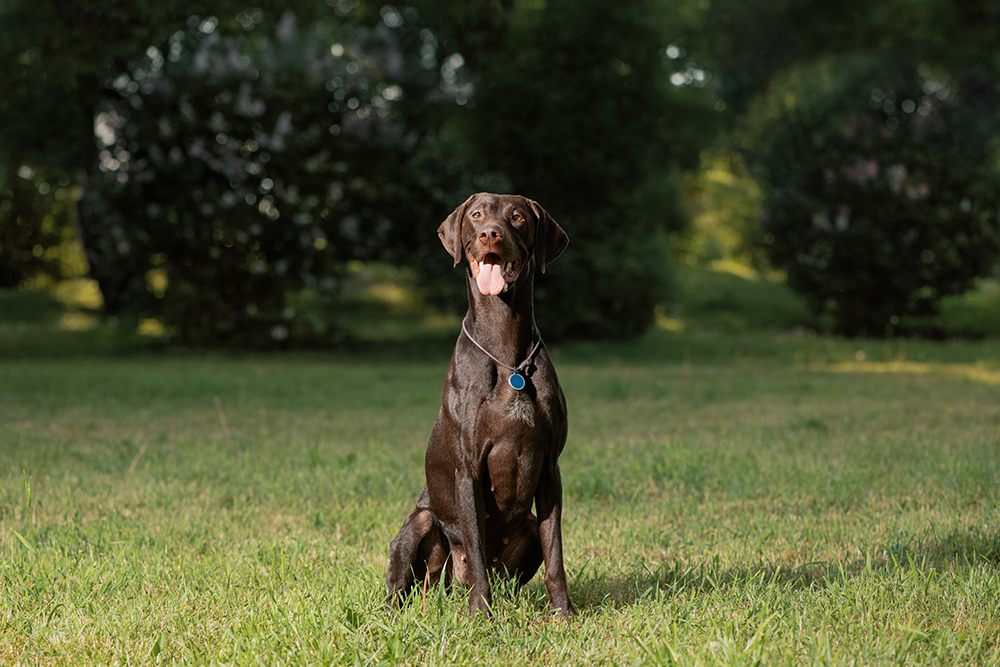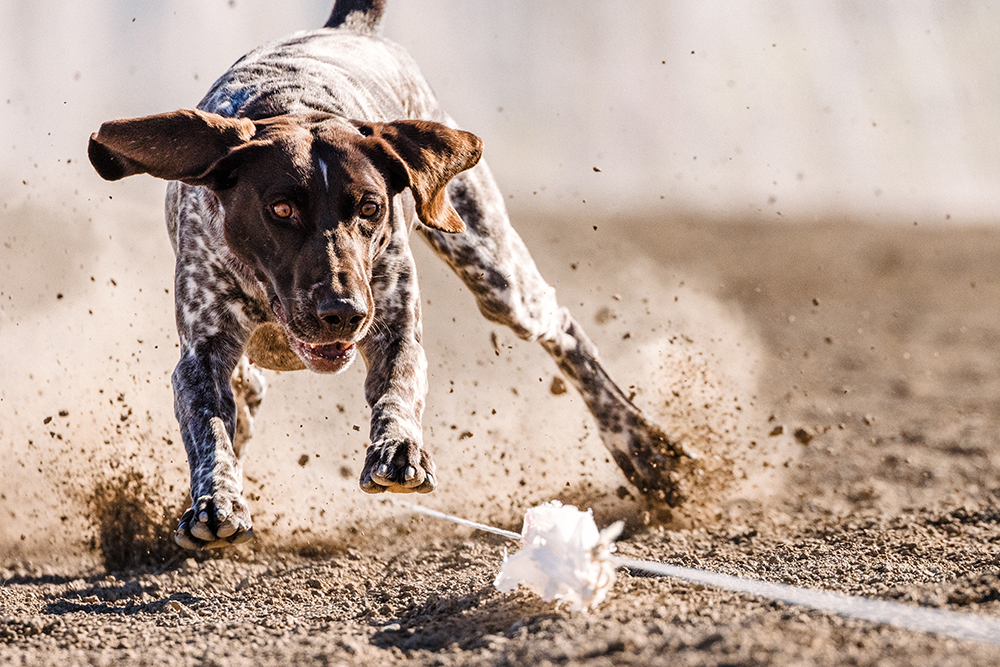In this article
View 8 More +Breed Overview
Height:
21 – 25 inches
Weight:
45 – 70 pounds
Lifespan:
10 – 12 years
Colors:
Liver, liver and white, liver roan, black, black and white, black roan
Suitable for:
Active, experienced dog owners, families with older kids
Temperament:
Energetic, friendly, smart, eager, good with kids, a bit stubborn
Several centuries ago, German hunters painstakingly developed a new bird dog breed that was smart, fast, and big enough to hunt larger prey if needed. From their efforts, the German Shorthaired Pointer was born. Today, the “GSP,” as they’re frequently referred to, is one of the most popular breeds in the United States.
Although their energy levels and occasional stubbornness can make them a challenge for first-time dog owners, the German Shorthaired Pointer makes a charming, playful companion with the proper guidance and appropriate amount of exercise. In this article, we’ll cover what you need to know about owning a German Shorthaired Pointer, including their temperament, care, and history.
German Shorthaired Pointer Characteristics

German Shorthaired Pointer Puppies

German Shorthaired Pointers are currently ranked in the top 10 most popular purebred dogs in the United States. Because of that, you’ll likely have several options for finding a puppy to add to your family.
If you choose to buy a GSP from a breeder, carefully research your choices. Popular breeds are always a temptation for unethical breeders who may not prioritize producing the healthiest dogs. German Shorthaired Pointers are prone to several inherited health conditions, and responsible breeders will always screen for them.
If you prefer to adopt your new pet, look for a rescue group specializing in German Shorthaired Pointers or possibly hunting dogs more broadly. Puppies may be harder to come by from these groups, but if you’re more flexible about the age of your new dog, you should be able to find a GSP to adopt. You can also check your local animal shelter or humane society.
German Shorthaired Pointer puppies have endless energy and need plenty of exercise. However, you don’t want to put too much stress on their growing bodies, so check with your vet about ideal activities for them at this age. However, you can get started on training and socializing your puppy as soon as they come home.
Regular routines and structure will help your young German Shorthaired Pointer learn what behavior is expected of them. Without it, the energetic dog can be a handful to live with.

Temperament & Intelligence of the German Shorthaired Pointer
Originally bred as hunting dogs, German Shorthaired Pointers love humans and bond closely with their families. They are smart and typically eager to please, but they have an independent streak that can make training challenging.
German Shorthaired Pointers are not a hands-off breed. They require a lot of attention and can be demanding if they aren’t getting it. Without consistent training and regular exercise, they can also become destructive.
In the right environment, German Shorthaired Pointers make amazing pets, especially for active owners. They are loving, protective, energetic, and playful dogs. With the proper motivation and guidance, they learn quickly and are excellent partners for those who enjoy hunting or participating in field trials and other canine sports.
Are These Dogs Good for Families? 👪
German Shorthaired Pointers have the energy and personality to make excellent playmates for kids. However, they can be too energetic and rambunctious for small children. They are best suited for families with older kids who enjoy physical activity. German Shorthaired Pointers and energetic kids are a great match because they can help wear each other out!
Of course, you should still supervise interactions between a German Shorthaired Pointer and children. Unfortunately, the German Shorthaired Pointer is not a good fit for families who don’t have a fenced yard or access to safe outdoor space for running. Without this outdoor access, providing enough exercise can be hard.
Busy families should also consider whether they have the necessary time to devote to training and exercising a GSP.

Does This Breed Get Along With Other Pets?
German Shorthaired Pointers usually get along with other dogs, although there are exceptions to this rule. The combination of hunting instincts, excessive energy, and a protective streak can lead some to be aggressive or confrontational toward other dogs. Early socialization with other dogs will certainly help.
With their hunting ancestry, German Shorthaired Pointers may chase cats or smaller dogs. They should also be kept separate from small exotic pets, especially birds.

Things to Know When Owning a German Shorthaired Pointer:
Before you search for a German Shorthaired Pointer puppy, you’ll want to be sure your whole household is prepared for the new pet first. Here’s what you need to know when owning a German Shorthaired Pointer.
Food & Diet Requirements 🦴
German Shorthaired Pointers typically don’t have any special diet requirements. They can eat any nutritionally balanced food formulated for their life stage. If your dog is incredibly active and regularly participates in hunting or canine sports, they may need a higher protein diet to fuel their muscles.
Talk to your veterinarian to help balance your German Shorthaired Pointer’s nutritional needs. While the dogs aren’t prone to obesity, you’ll still want to feed the correct number of calories each day. Your vet can help you calculate how much your dog should eat based on their age, size, and activity level.

Exercise 🐕
To keep a German Shorthaired Pointer fit and happy, they should get at least 1-2 hours of exercise daily. Strolling around the neighborhood typically isn’t enough activity for them either. Plan on long walks, jogs, hikes, or running off-leash in a safe area instead.
German Shorthaired Pointers are true athletes who enjoy agility, field trials, dock diving, and tracking competitions. If they don’t have a healthy outlet for their energy, German Shorthaired Pointers will get bored and frustrated and develop destructive behaviors. Meeting their daily exercise demands is a must, and it can be quite a commitment.
Training 🎾
German Shorthaired Pointers were bred to work alongside humans, and they’re capable of learning quickly. However, training a GSP can be challenging because they’re also independent at times. They are usually a better fit for more experienced dog owners. Firm, consistent, yet positive training methods will be the most successful.

Grooming ✂️
Generally, keeping a German Shorthaired Pointer well-groomed isn’t time-consuming. Their short coats shed year-round, with seasonally heavier hair loss. You’ll want to brush them every few days or as needed to keep the shedding under control.
Check your GSP’s ears frequently and clean them as needed, especially if the dog plays outside often or swims. Keep their nails trimmed short to prevent them from getting snagged and torn. Finally, talk to your vet about options for preventative dental care.
Health and Conditions 🏥
Like nearly all popular purebred dogs, German Shorthaired Pointers are prone to several inherited health conditions. Before purchasing a puppy from a breeder, ask to see the family health history and the results of genetic screening tests.
- Progressive retinal atrophy
- Bloat
- Hip and elbow dysplasia
- Subaortic stenosis
Male vs Female
Male German Shorthaired Pointers are usually taller and heavier than females. Generally, male dogs are more energetic, bold, and protective than females. Unneutered males are prone to wandering in search of females in heat and are more likely to display unpleasant behaviors like frequent urine marking or humping.
Female German Shorthaired Pointers go into heat about twice a year and must be kept separated from unneutered males during those periods. Both male and female German Shorthaired Pointers can make wonderful pets, and the choice between the two sexes often comes down to personal preference.

3 Little-Known Facts About the German Shorthaired Pointer
1. It took centuries to develop the modern German Shorthaired Pointer.
The development of the German Shorthaired Pointer dates to the 1600s. However, it wasn’t until the 1800s that German breeders were finally satisfied with their shorthaired Pointer. Breeds such as the Spanish Pointer, Hannover Hound, and English Pointer all made their way into the bloodline of the German Shorthaired Pointer.
2. A GSP named Marvin from North Carolina won 75 AKC titles by 2013.
Although they’re well-known for their hunting skills, German Shorthaired Pointers are also incredible athletes. Marvin’s 75 titles are testaments to the breed’s versatility.
3. German Shorthaired Pointers are more popular in America than in Germany.
The American Kennel Club recognized the German Shorthaired Pointer in 1930. In their native Germany, the German Wirehaired Pointer is more popular than the Shorthair. However, Americans prefer the shorthaired version.

Final Thoughts
German Shorthaired Pointers are a fine example of the truth that not every breed suits every living situation. As sweet, adorable, and entertaining as they can be, the German Shorthaired Pointer is not the dog for everyone.
Keeping all their energy channeled appropriately is more work than inexperienced dog owners might realize. German Shorthaired Pointers plenty of exercise, patience, and attention, and it’s important you know what you’re getting into before you welcome one into your home.
Featured Image Credit: brixiv, Unsplash




















One Response
My husband and I have a German shorthaired pointer. She turned five today and out of about eight breeds that we’ve had combined, this is the best dog we’ve ever had. We are in our 70s, but she gets plenty of exercise and loves to run and hunt with my husband . Super super smart and easy to train, she never gets into anything and is the best companion, the most loving lap dog you’d ever want; if you want an all-around great dog, get a German shorthaired pointer. I can’t recommend them enough.